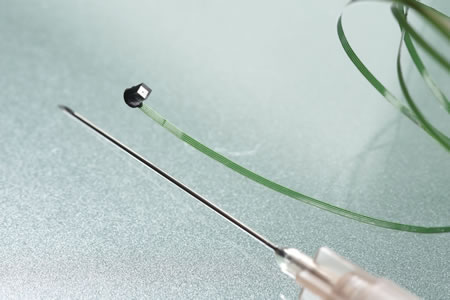Science Fiction
Dictionary
A B C D E F G H I J K L M N O P Q R S T U V W X Y Z
Microcamera Big As Grain Of Salt

A microcamera no larger than a coarse grain of salt has been developed at the Fraunhofer Institute for Reliability and Microintegration in Berlin, Germany.

(Microcamera as large as coarse salt)
Digital camera systems consist of two components: a lens and a sensor that transforms the image into electrical signals. Electrical contacts on the sensor allow access to these signals and therefore also to the information of the image. Due to the way they are manufactured, these contacts are located between the sensor and the lens...The researchers at the Fraunhofer Institute for Reliability and Microintegration have streamlined this process by developing a new way to access the electrical contacts. Now, the wiring process is faster and the entire camera system is smaller. The trick lies in the fact that they do not reach the contacts of each individual image sensor via the side any more but rather, simultaneously, with all sensors via their reverse side while they are still connected as a wafer. That means that you no longer have to mount the individual lenses. Instead, you can connect them with the image sensor wafers as lens wafers. Only then is the stack of wafers sawed apart into individual microcameras. Another upside is the fact that it supplies razor-sharp pictures even with very thin endoscopes. To date, the camera systems built into them had to be divided because of their size. The lens was at the tip of the endoscope and the sensor at the other end of the glass fiber strand. The new microcamera is small enough for the tip of the endoscope. It has a resolution of 25,000 pixels and transmits the image information through the endoscope via an electrical cable. Stephan Voltz, who is the CEO of Awaiba GmbH, says that “at 0.7 times 0.7 times 1.0 millimeters, this camera is as small as coarsely ground grain of salt – the smallest camera that we are aware of.”
This new camera will be manufacturable for pennies, making disposable cameras available for a variety of purposes.
When I read about this, I thought that they would be just the thing for tiny micro aerial vehicles, like Raymond Z. Gallun's Scarab robot flying insect from his 1936 short story The Scarab; it had "minute vision tubes" to bring an image to its remote operator.
Scroll down for more stories in the same category. (Story submitted 3/5/2011)
Follow this kind of news @Technovelgy.| Email | RSS | Blog It | Stumble | del.icio.us | Digg | Reddit |
Would
you like to contribute a story tip?
It's easy:
Get the URL of the story, and the related sf author, and add
it here.
Comment/Join discussion ( 0 )
Related News Stories - (" Engineering ")
Tornyol Microdrone Kills Mosquitoes
'The real border was defended by... a swarm of quasi-independent aerostats.'
PLATO Spacecraft, Hunter Of Habitable Planets, Now Ready
'I ... set my automatic astronomical instruments to searching for a habitable planet.' Edmond Hamilton (1936).
Did The Yautja Have These First?
What a marvel of ingenuity the little device was! - Harry Bates, 1934.
Jetson ONE Air Races Begin, Can Air Polo Be Far Behind?
'If you're one of those rarities who haven't attended a rocket-polo "carnage", let me tell you it's a colorful affair.' - John Victor Peterson, 1938.
Technovelgy (that's tech-novel-gee!) is devoted to the creative science inventions and ideas of sf authors. Look for the Invention Category that interests you, the Glossary, the Invention Timeline, or see what's New.
Science Fiction
Timeline
1600-1899
1900-1939
1940's 1950's
1960's 1970's
1980's 1990's
2000's 2010's
Current News
Natural Gait With Prosthetic Connected To Nervous System
'The leg was to function, in a way, as a servo-mechanism operated by Larry’s brain...'
Woman Marries Computer, Vonnegut's Dream Comes True
'Men are made of protoplasm... Lasts forever.'
Spidery 'Walk Me' Toyota Autonomous Wheel Chair Like Star Wars
Walk along with the emperor.
Dancing Robots Taught Dance Moves
'A clockwork figure would be the thing for you...'
Proof Of Robothood - Not A Person
'Who are you people? - Show 'em.'
Indonesian Clans Battle
'The observation vehicle was of that peculiar variety used in conveying a large number of people across rough terrain.'
The 'Last Mile' In China Crowded With Delivery Robots
Yes, it's a delivery robot. On wheels.
Tornyol Microdrone Kills Mosquitoes
'The real border was defended by... a swarm of quasi-independent aerostats.'
PLATO Spacecraft, Hunter Of Habitable Planets, Now Ready
'I ... set my automatic astronomical instruments to searching for a habitable planet.'
Factory Humanoid Robots Built By Humanoid Robots
'...haven't you a section of the factory where only robot labor is employed?'
iPhone Air Fulfils Jobs' Promise From 2007 - A Giant Screen!
'... oblongs were all over the floor and surfaces.'
ChatGPT Now Participates in Group Chats
'...the city was their laboratory in human psychology.'
iPhone Pocket All Sold Out!
'A long, strong, slender net...'
Did The Yautja Have These First?
What a marvel of ingenuity the little device was!
Jetson ONE Air Races Begin, Can Air Polo Be Far Behind?
'If you're one of those rarities who haven't attended a rocket-polo "carnage", let me tell you it's a colorful affair.'
Will Space Stations Have Large Interior Spaces Again?
'They filed clumsily into the battleroom, like children in a swimming pool for the first time, clinging to the handholds along the side.'
